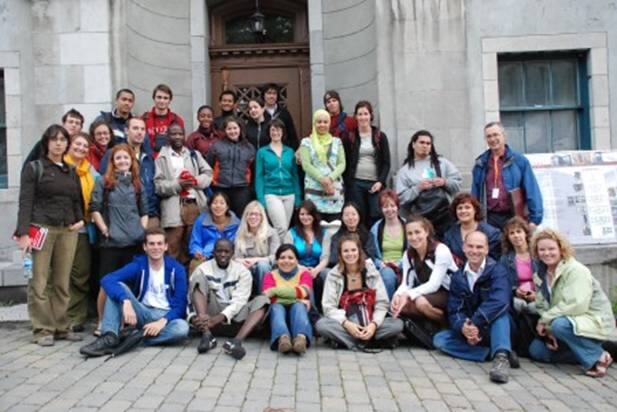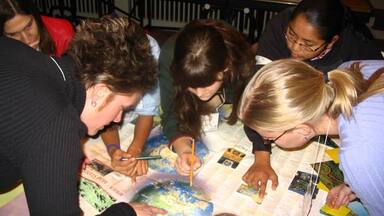From 21 June to 10 July 2008, thirty young people met in Canada to deepen their knowledge of different aspects of World Heritage in the framework of the 32nd session of the World Heritage Committee.
Organizers
The event was organized by Parks Canada and the Canadian Commission for UNESCO.
Countries represented
Barbados, Brazil, Canada, Costa Rica, Croatia, Germany, Indonesia, Lebanon, Mexico, Morocco, New Zealand, Norway, Republic of Korea, Senegal, United Republic of Tanzania and the United States of America.
Objectives
- Create a direct link between youth and the World Heritage Committee meeting.
- Facilitate the direct contribution of youth to the work of the Committee.
- Stimulate interest in young people in World Heritage and help them to learn more about it.
- Encourage young people to share their knowledge and experience on subjects related to World Heritage.
- Create lasting results likely to be applied after the Forum.
Theoretical training
During different workshops held in Ottawa and Québec, the participants discussed themes such as shared heritage of humankind, the preservation of natural sites, cultural heritage, the link between journalism and World Heritage, the inscription process on the World Heritage List as well as the functioning of the World Heritage Committee.
Major actors involved in World Heritage preservation also shared their expertise with participants in the workshop, including: the UNESCO World Heritage Centre, the International Union for the Conservation of Nature (IUCN), the International Council on Monuments and Sites (ICOMOS), Hostelling International, the Organization of World Heritage Cities (OVPM), Parks Canada and the Canadian Commission for UNESCO.
Practical knowledge acquired
The thirty young people were able to learn on site about the history and management of several Canadian sites inscribed on the World Heritage List. In this way the participants had the opportunity to learn more about Rideau Canal, as well as the rich history and fortifications of the Historic District of Old Québec. This visit was all the more interesting as the city of Québec was celebrating its 400th anniversary.
The young people were also divided into three groups for a few days in order to see the practical application of theories learned during the workshops. The first group went to southern Alberta where they could experience firsthand the historic importance of Head-Smashed-In Buffalo Jump, go back in time 75 million years to Dinosaur Provincial Park, and see the role of World Heritage in dialogue between two countries in the transboundary site of Waterton Glacier International Peace Park.
A second group went to Canadian Rocky Mountain Parks, located at the junction between Alberta and British Columbia, where they could see the splendor of the landscape on the route that took them from Banff to Yoho Park, in passing by the majestic Louise Lake.
Finally, a third group went to the eastern part of the country, to Newfoundland and Labrador. There they were able to experience the beauty and geological wealth of Gros-Morne National Park and learn more about Viking ruins at L’Anse-aux-Meadows National Historic Site.
The presence of youth at the Committee
For the organizers, it was important to allow the young people to understand and experience how the World Heritage Committee functions. For the first time this year, the participants were paired with different country and organization delegations and were able to sit in on the 32nd session of the World Heritage Committee as well as at different regional and thematic meetings. The participants could also see the organizational efforts required for the management and organization of the Committee in taking part in various supportive tasks.
Two special documentaries were produced with the participation of youth. They will be aired at various times on Canal Savoir beginning December 1st, 2008. The documentaries will be simultaneously aired online on Canal Savoir’s Website. They are available online at: www.canal.qc.ca
The legacy
United in their common interest for World Heritage and its conservation, the young people developed different projects aimed at insuring the continuity of the event once it was over. The interactive site “Six Billion People, One Common Heritage” was launched thanks to a competition by the Citizen Shift Web site of the National Film Board of Canada. The participants contributed by proposing texts, photos and videos illustrating their experience. Today the site is a platform for exchange and discussion among young people of different regions interested in World Heritage, and everyone, not only the participants, is invited to contribute to it in adding information on the sites in their country or for those for which they have a particular attachment.
Afterward, the young people produced a video on World Heritage corresponding to their experience. Having received training on how to use the software iPhoto and iMovie during their trip to Ottawa, the participants contributed their own images and texts to the video. Copies will be distributed to different partners in different regions of the world. A second version of the video containing more pedagogical material will be produced and distributed to different universities.
Hostelling International Christina Cameron Youth Awards
In the end, the youth were led to reflect on a project they would like to develop in their community following their experience, in order to share what they had learned with as many others as possible. For the first time, the Hostelling International Christina Cameron Youth Awards were given to three projects illustrating the highest potential for reinvestment in the community. It is important to note that the young people were actively involved in the award process. The recipients, chosen by the young participants, are: Ansoumane Sané of Senegal; Taryn Barry of Edmonton, Canada; and Hari Wibowo of Indonesia. Follow-up of the projects will take place in 2008-2009.
Contacts
For more information, please contact:
- Cynthia Lacasse
Program Agent for Youth
Canadian Commission for UNESCO
cynthia.lacasse@unesco.ca
www.unesco.ca - Lise Auger
Project Manager, 32nd session of the World Heritage Committee
Parks Canada
lise.auger@pc.gc.ca
www.canada2008.ca


